STATIC FRICTION:
The Complete Guide

Imagine searching the web continuously for different articles on static friction.
What if there is one single article out there that’s well designed to clarify all your questions and doubt on static friction.
You will probably be pumped to read through it right?
Luckily for you, that’s exactly what I’m going to share with you in this post.
Everything you need to know about static friction in one single article.
At the end of this guide, I will show you some real-life applications of static friction.
Let’s get started.
Contents
Contents
CHAPTER 1
STATIC FRICTION: Definition and Explanation

What is static friction?
Static friction is the friction force between two surfaces at rest relative to each other.
It is the friction that exists between the contacting surfaces of static objects.
The static friction force must be overcome by the applied force before an object can move.
Once the object is set in motion, kinetic friction takes over.
For instance;
Consider pushing an object of weight 200N across a surface with friction resistance of 100N
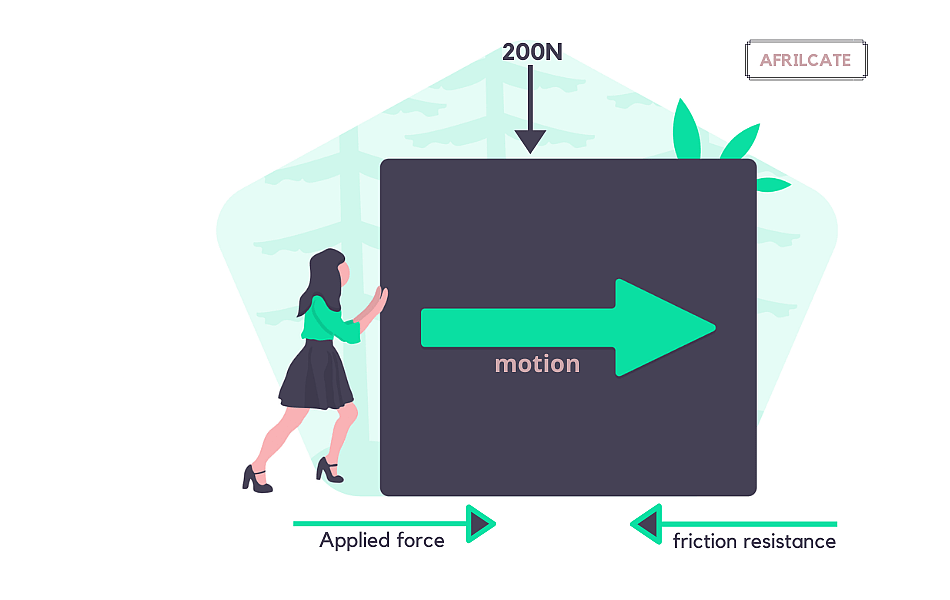
For the object to move, the applied force exerted by the lady must be greater than the friction resistance. This means that the push exerted must be greater than 100 N.
Let’s take a quick look at the friction plot.
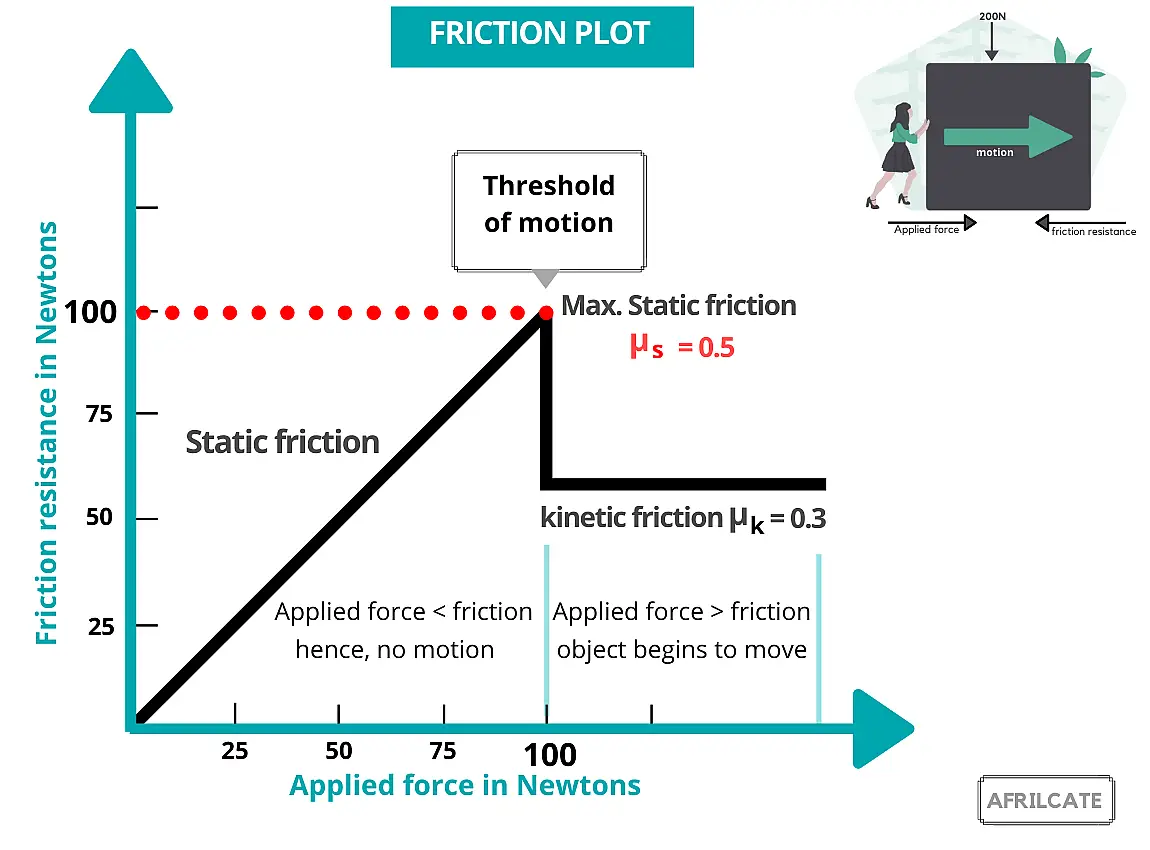
From the plot, you will observe that, the object begins to move when the applied force exceeds the maximum static threshold.
Friction acts opposite the direction of the net applied force.
µs represents the coefficient of static friction. We’ll talk more on this in subsequent chapter.
Generally, the word “static” refers to an object at rest or in a stationary position.
Can you think of any object in a stationary state?
Then, the object is said to be under the influence of static friction.

This is a desk lamp sitting undisturbed on the table.
There is static friction between the bottom hub of the lamp and the table top.
I guess you are also sited on a chair right now. If so, then static friction exists between your butt and chair surface.
Without this static friction, you might sink into the chair just like dropping a pebble in an ocean.
One major thing to note here is that, friction is a contact force.
This means that it can only exist between surfaces that are physically in contact.
CHAPTER 2
Causes of Static Friction

What causes static friction?
Static friction is caused by:
- Interlocking of surface irregularities or asperities.
- Material Deformation of static object.
- Intermolecular bond due to surface adhesion.
- Stickiness of contact surface.
- Surface abrasion between contacting pairs.
- Surface roughness or degree of smoothness.
INTERLOCKING OF SURFACE IRREGULARITIES
All objects have rough planes regardless of how smooth they may appear.
It might not be visible to the naked eyes but can be detected using microscopic lenses.
These minute rough planes are called surface irregularities.
The interlocking of these surface irregularities give rise to static friction.
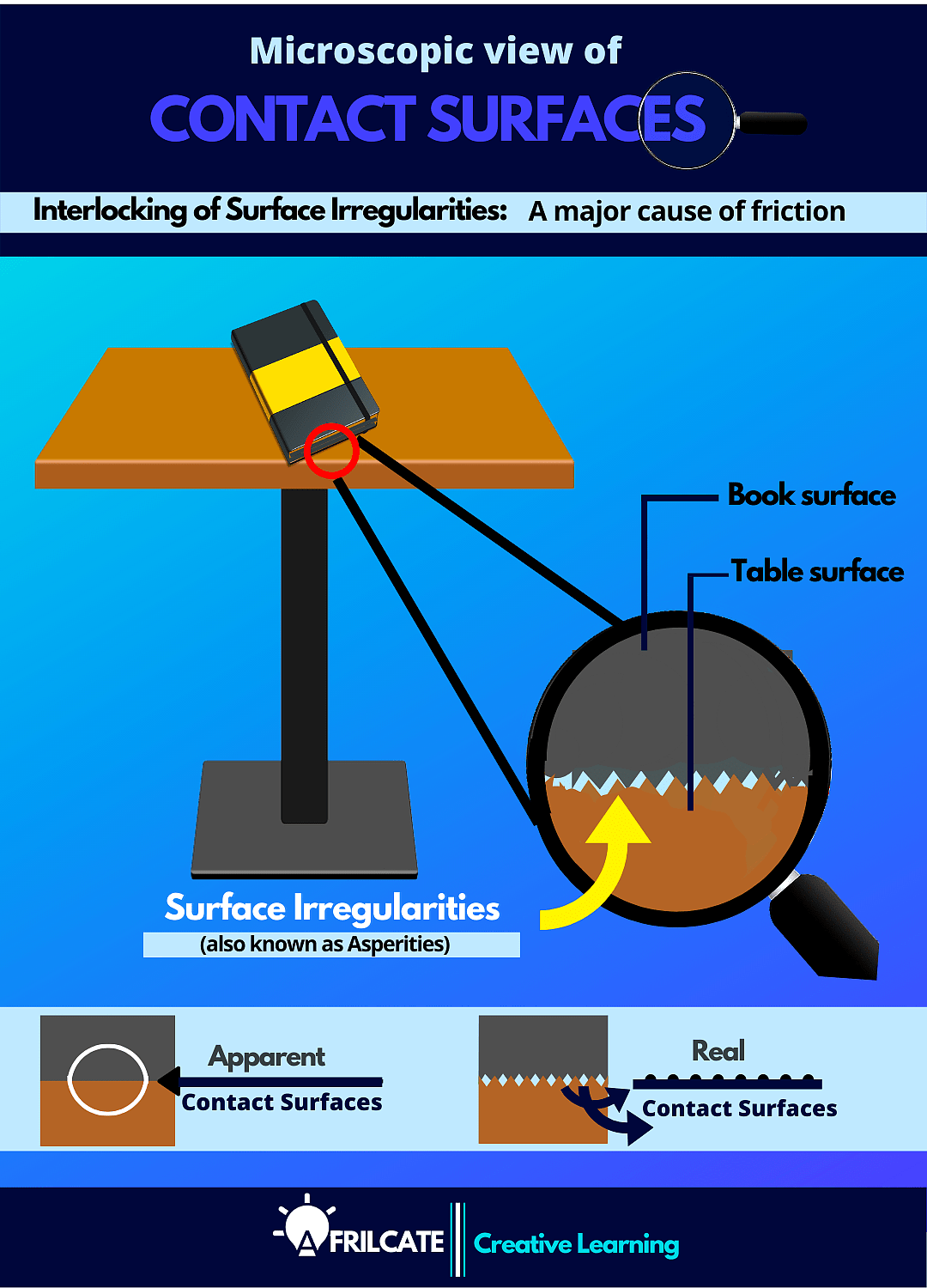
Microscopic view of two surfaces in contact
Surface irregularity are also called Asperities; a common term in material science that defines the unevenness of surfaces.
Even if the surface is polished, it still contains tiny bits of unevenness.
Apparently, there is no known material surface that is completely devoid of surface irregularity.
Surface asperity consists of:
- Surface Hills (mountains)
- Surface Valleys (grooves)
The choice of term is left for you. You can say hills and valleys or mountains and grooves.
You can also cross-interchange the terms, still acceptable.
The question is,
what do these terms have to do with friction?
The informative diagrams below gives a clearer explanation.
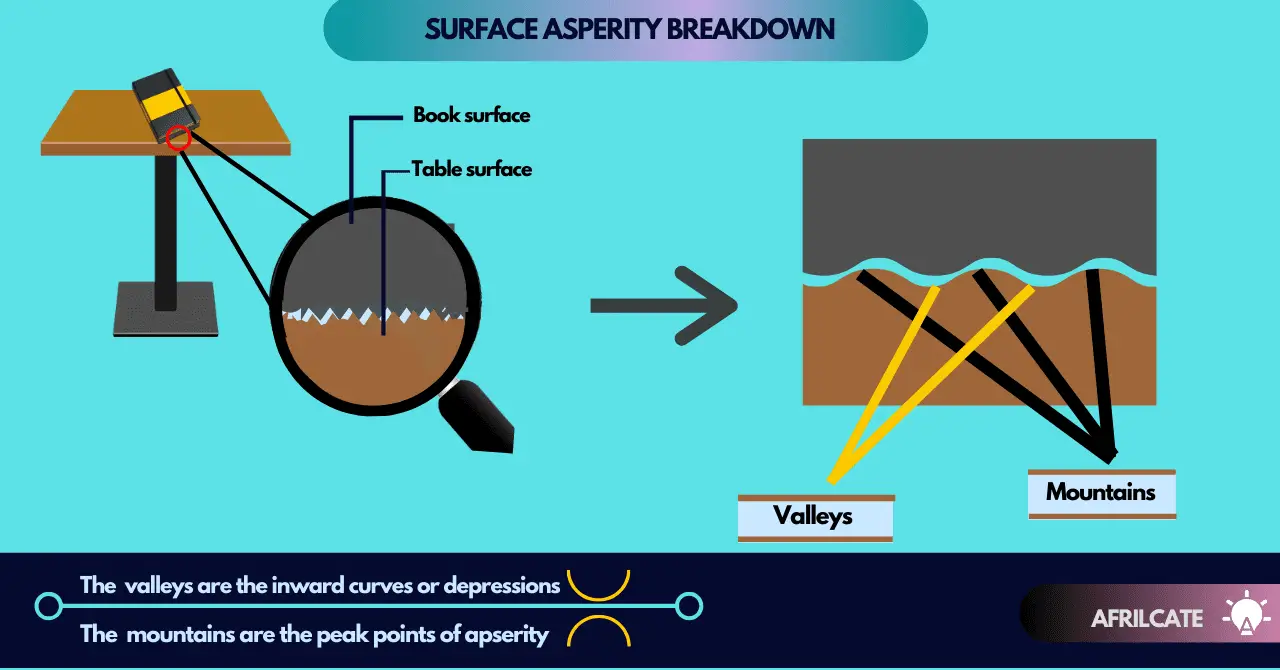
Much like the geographic land form you are familiar with:
An Asperity valley is the lower points or depression. It’s either U-shaped or V-shaped.
The mountains of the asperity are the higher points of the irregularity or the elevations.
Since mountains are opposite of valleys, It’s the upside-down (U-shape or V-shape).
When we try to move one object over another object, these mountains and valleys gets entangled or locked with one another.
This opposes the motion of one object over the other and give rise to the force of friction.
From a detailed perspective, the interlocking of irregularities refers to the locking together of minute surface mountains and valleys of contact objects.
Due to this microscopic surface unevenness, the actual contact area is slightly less than what is expected when viewed with the naked eyes.

Deductive implication;

MATERIAL DEFORMATION OF STATIC OBJECT
Deformation is another cause of static friction.
The deformation can be elastic or plastic. The force of friction will increase if the two surfaces are pressed harder.
This means an increase in weight will lead to a corresponding increase in static friction.
You can experience it by dragging a mat when nobody is sitting on it, and when a child is sitting or lying on it.
The weight of an object directly affects the material deformation.
The deformation will continue until the contact area is great enough to support the load.
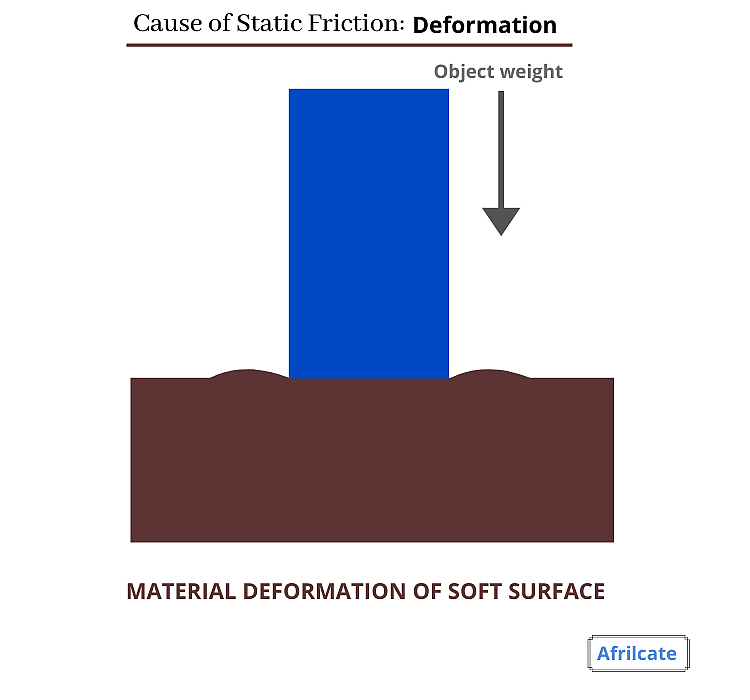
Excess weight acting on an object can lead to a permanent distortion of the object’s shape or orientation.
This non-reversible deformation is called plastic deformation and large deformation can leads to one object sinking into the other.
Generally, soft material deforms under pressure.
Although such deformations are elastic in nature, it still increases the resistance to motion.
Some common examples of elastic deformation due to friction includes:
- Slight inward depression of our feet when standing on a rug.
- Weight dip when we lie on the bed
- Sitting on an office leathered chair
- Cuddling a pillow
- Rubber tire flattens out at the area of contact with the road.
Deformation creates a ploughing effect. i.e. the slight “sinking “of the hard object when placed on a soft surface.
If the hard object is pushed across a soft surface, then the ploughing force must be greater than the resistive force to enable motion.
Hence, the resistive force comes into play whenever the tip of the hard object plough (move) through the surface.
Ploughing as a friction component arises due to material deformation.
Therefore, it is largely dependent on the penetration depth.
INTERMOLECULAR BOND DUE TO SURFACE ADHESION
Surface Adhesion is the driving force of static friction.
Adhesion is the force of attraction between molecules of different substances.
When two objects or surfaces are brought into contact, the adhesive or electromagnetic forces attracts the molecules of the two objects together.
Think of the rain droplets on your window after rainfalls or morning dew.

The force of adhesion between the liquid droplets and the glass surface prevents it from sliding down thereby maintaining a stationary position.
The static nature of the object makes it possible for stronger molecular bonding which in turn leads to a rigid conjoined surface asperity.
This is one major difference between static and kinetic friction. Since kinetic friction involves motion, the molecules in contact don’t get the chance or needed time to form such strong adhesive bonds.
That’s why static friction force is greater than both sliding (kinetic) friction force and rolling friction force.
Trying to slide one object across the other requires breaking these adhesive bonds.
STICKINESS OF CONTACT SURFACES
Sticky surfaces also give rise to static friction.
The composition of some solid materials greatly increases their adhesion and makes them even “sticky” to the touch.
For two objects to stick together their surfaces must come in contact as closely, and at as many points, as possible.
This stickiness greatly increases friction.
Rubber and adhesive tape are examples of sticky materials that have this type of friction.
A common example of sticky surface is the household mouse glue.
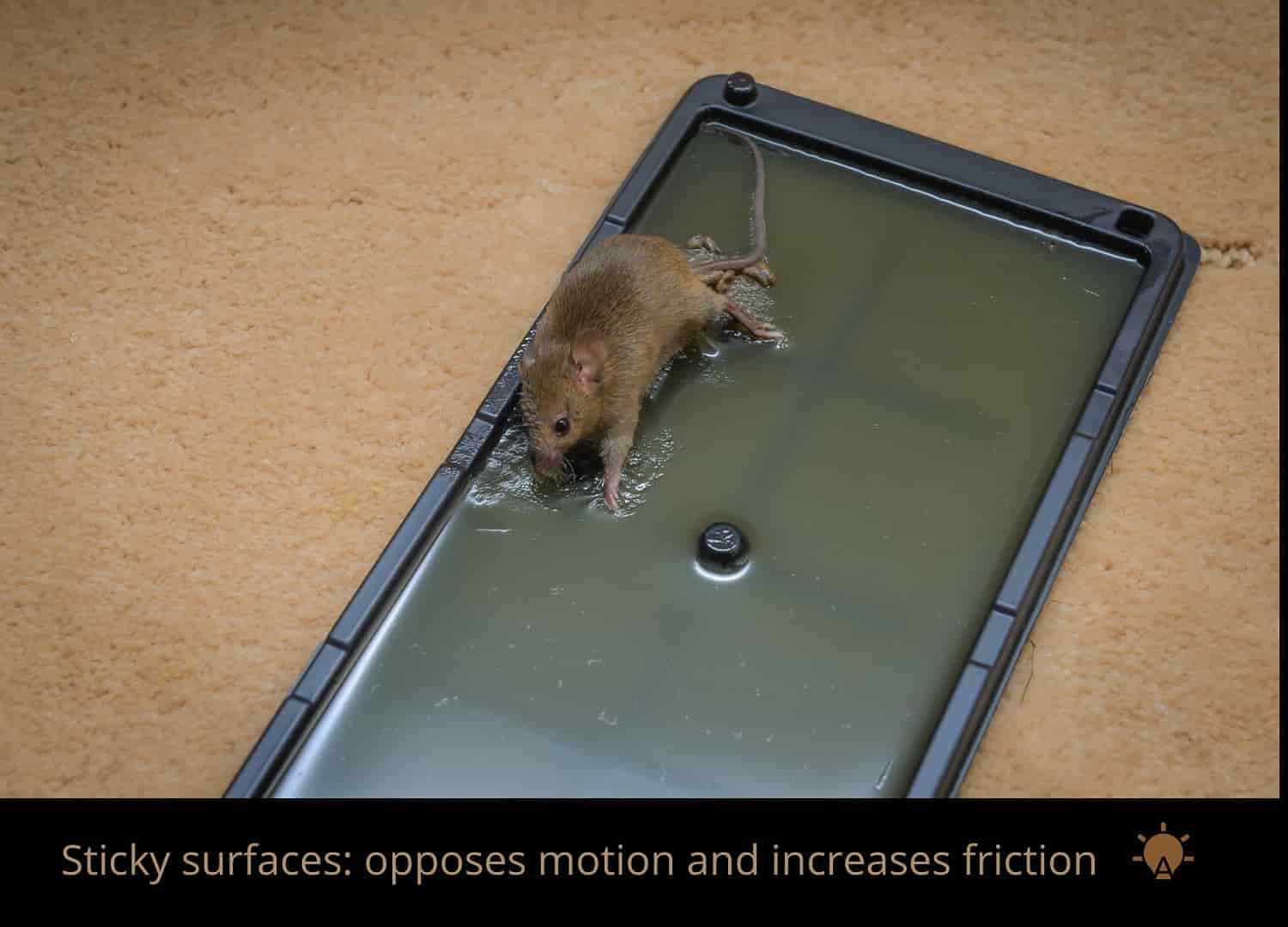
Since sticky surfaces enhance static friction, sticky materials like the sticky pad are used in automobiles to keep objects intact.
Sticky pad is a friction device used to prevent objects from sliding on a surface, by effectively increasing the friction between the object and the surface.
The pad has a large friction coefficient and a multifaced sticky property.
This means it maintains complete stickiness with the dashboard surface and also with the item laid on it.

Sticky pads are commonly used on car dashboards where forces caused by the acceleration of the vehicle would cause objects on dashboards to slip off.
DEGREE OF SURFACE ROUGHNESS OR SMOOTHNESS
We have said earlier that all solid materials have some degree of surface roughness irrespective of how smooth they may appear.
In many cases, rough surface is referred to as the primary cause of friction.
But this is not always true since adhesion, deformation and other friction causes listed above still have a role to play.
Nevertheless, the degree of the surface roughness greatly affects friction.
If two surfaces in contact are extremely rough, the surface irregularities will be easily locked together.
The increased contact points will strengthen the adhesive bond which will in turn lead to higher static friction.
On rough surfaces, there are a larger number of irregularities.
So the frictional force is greater if the surface is rough.
For practical purposes, try rolling a ball through a smooth surface.
Now, try rolling the same ball over a rough or coarse surface.
You will observe that the ball in the rough surface will quickly come to a stop compared to that of the smooth surface.
This means that surface roughness not only affects static friction but also rolling friction. Smoothening rough surface reduces the interlocking of asperities thus causing a decrease in static friction.
The smoother the surface the lower the friction force and vice versa.
To smoothen a rough surface, you can either use sandpaper or apply a coat of high coverage primer.
Lubricating contact surfaces is another common way of reducing friction.
SURFACE ABRASION BETWEEN CONTACTING PAIR
Abrasion is the process of scraping off or wearing away material surfaces by means of surface contact.
Surface abrasion hinders surface friction by reducing the material roughness.
When surface abrasion occurs, particles of the materials are dislodged from their surfaces. This reduces the chances needed for asperity interlocking and weakens static friction.
When we attempt to move any object, we have to apply a force to overcome interlocking.
For the object to slide over another surface, the adhesive force between the contact molecules must be broken. This process involves the abrasion of contact points.
This means that the interlocked areas must be broken apart or plastically deformed before the object can move.
Once movement is initiated, some abrasion continues to occur, but at a much-reduced level than the static position.
CHAPTER 3
Examples of Static Friction

Examples of Static Friction
There are various examples of Static friction.
Out listed below are some common examples:
- A standing lantern
- A car parked on a hill
- A standing fan
- A tightened bolt
- Clothes hung on a clothesline
- Rubbing a balloon or plastic pen on your head
- A ladder leaning against the wall
- Book kept on a surface
- Fruits hanging from a tree
- Static friction enables us to walk, run, jog etc.
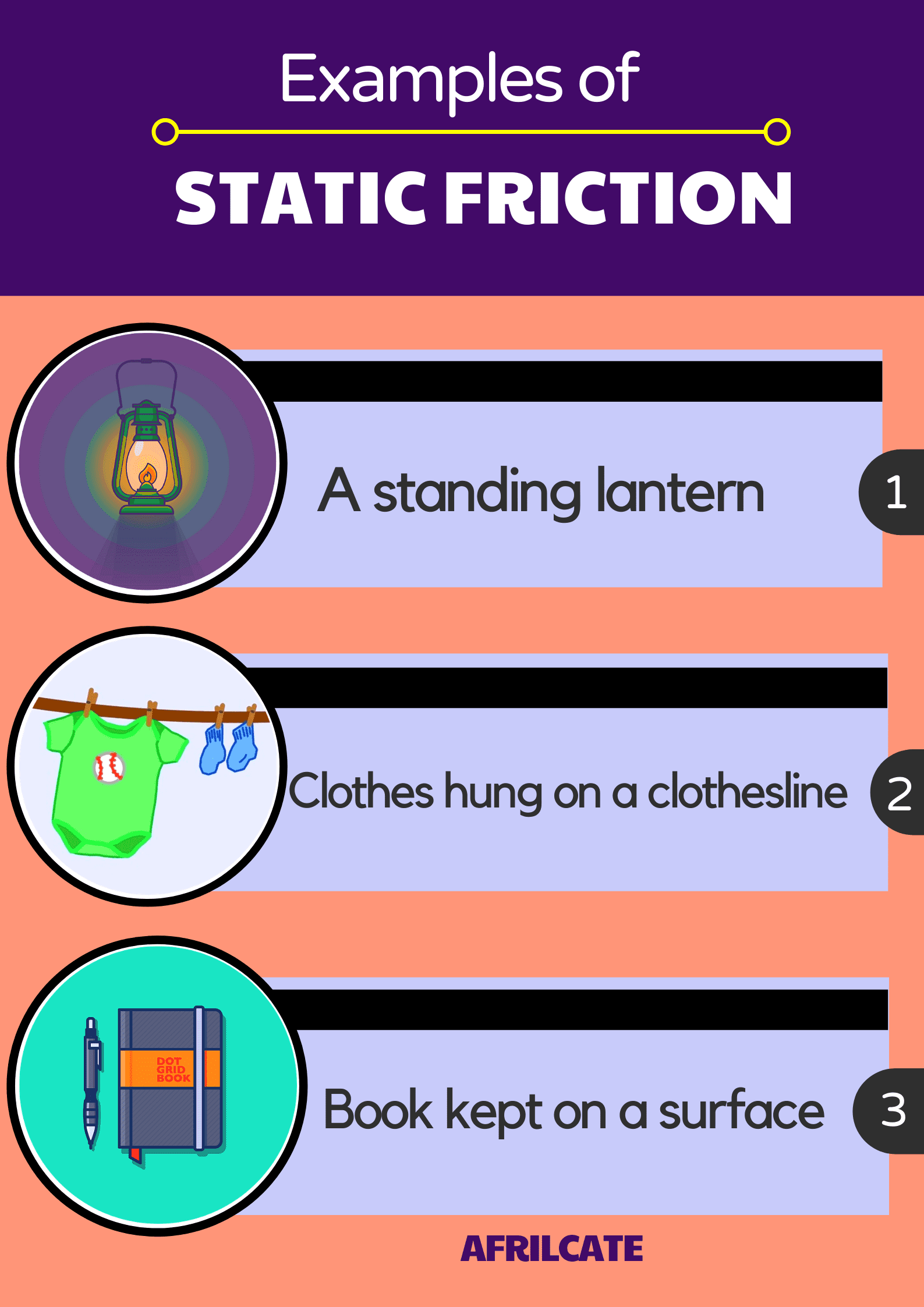
ooh, I played the musical instrument this morning before preparing this article.
And I took some photos thereafter.
Since they are sitting undisturbed on the bed, permit me to add this as another example of static friction.

Can you think of any other example of static friction around you?
Reserve your answers for the comment session at the end of this guide.
Let’s continue…
CHAPTER 4
Factors affecting Static Friction

Factors affecting Static friction
Friction factors are different from friction causes although they are closely related.
The different friction causes listed above can be properly grouped into three major factors of static friction.
The factors affecting static friction are:
- Nature of surfaces in contact
- Weight of object
- Coefficient of Static friction
Apparently, the factors affecting static friction is the same as that affecting friction generally.
The only difference is the specific reference given to the friction coefficient.
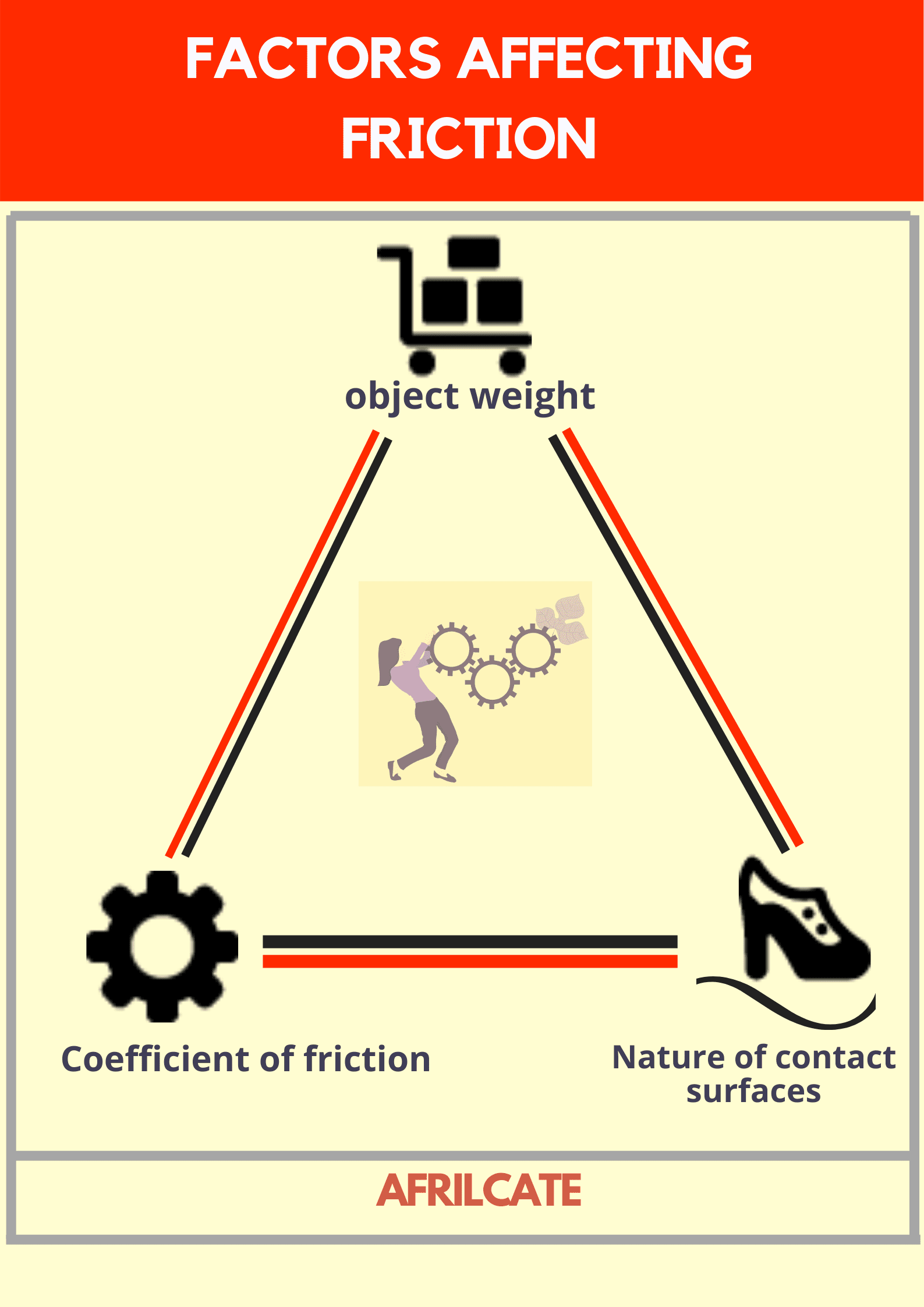
Let’s see how these different factors affect static friction.
Nature of surfaces in contact
Static friction greatly depends on the nature of the contact surfaces.
Majority of the friction causes centers around the surface nature of the objects at the point of contact.
This is in accordance with the Laws of friction.
To know if a given pair of contact surface will have high static friction, you need to ask yourself the following questions:
- Does the object material permit asperity interlocking?
- How strong is the adhesive force between the contact surfaces?
- Is the contact surface rough or smooth?
- Is the surface sticky?
The nature of the surface in contact will provide all the needed answers to these questions.
✔ If the surface is polished, asperity interlocking will be minimal.
✔ The adhesive force depends on the interactions of the surface molecules.
✔ Rough and sticky surface increases static friction.
Weight of object
The weight of the object is directly proportional to static friction.
The object weight determines the degree of the material deformation and also responsible for surface abrasion.
The normal force acting on an object depends on the weight of the object.
Normal forces are support forces that assist an object to stay at the surface of another object.
Depending on the inclination of the surfaces, the normal force can act at an angle but if the surface is even or flat, the normal force equals the force of gravity.
A greater weight pushes the surfaces together, causes more of the asperities to come together, and increases the contact surface.
Therefore, an increase in object weight will lead to a corresponding increase in static friction and a decrease in weight will lead to a decrease in static friction.
Coefficient of static friction
The Coefficient of friction is a numerical value that quantifies the intensity with which two sliding or contact surfaces grip each other.
Also known as friction coefficient, it measures the degree of “stickiness” of surfaces in contact.
The static friction coefficient tells us the extent or degree with which static objects and contact surface grip each other.
The coefficient of static friction is typically larger than the coefficient of kinetic friction and the rolling friction coefficient.
This is expected because the static position allows more time for asperity locking and molecular bond formation unlike objects in the sliding or rolling state.
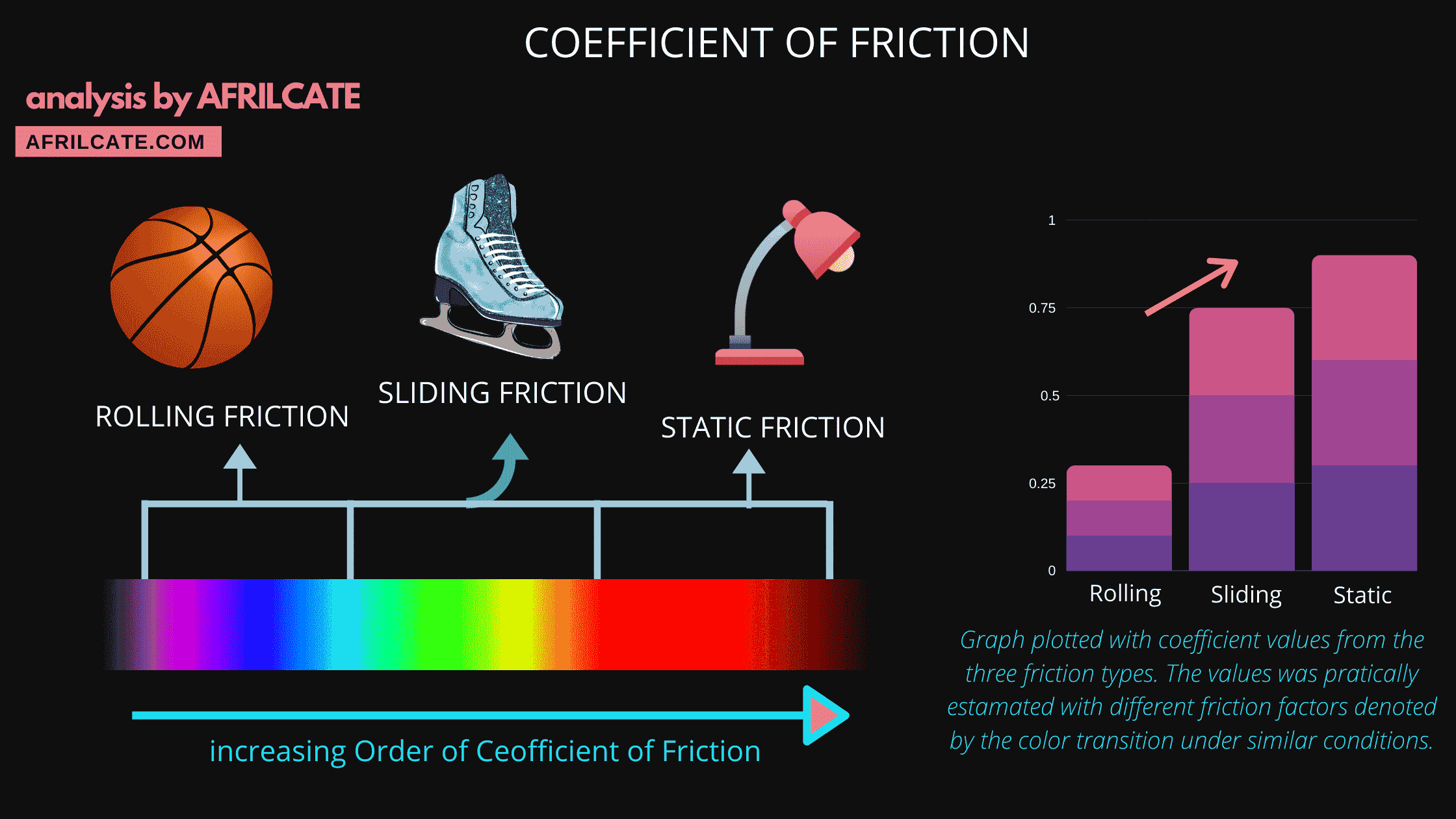
Graph plotted with coefficient values from the three friction types.
The values were practically estimated under similar conditions. These conditions are denoted by the color transition in each column of the friction coefficient plot.
Since the static friction coefficient is higher, more force will be required to initiate motion if an object is stationary.
Coefficient of friction is symbolized by the Greek letter µ, while the static coefficient of friction is denoted with µs.
The higher the coefficient of friction, the higher the frictional force.
Similarly,
The higher the static friction coefficient, the higher the static friction force.
CHAPTER 5
Calculations on Static Friction

Calculations on static friction
The formula for static friction is given as the product of the coefficient of static friction and normal force.
|
Fs = µs N |
Where,
- Fs is the force of static friction
- µs is the coefficient of static friction
- N is the normal force, sometimes it’s denoted by η
Normal force has the same magnitude as the weight.
It’s represented by the equation; N = m x g
If the object or plane is inclined at an angle (∅), the normal force becomes:
N = m gcos∅
Where m = mass of the object.
And g = acceleration due to gravity.
F and N are measured in units of force (such as Newton or pound).
Since friction is a force, the unit of the frictional force is the newton (N).
The coefficient of static friction is unitless.
For an object to be set in motion, the applied force must be greater than the force of static friction, Fs.
This is best thought of as a maximum value because it increases up to a certain max. point and when this point is exceeded through the addition of external force, the object begins to move.
At this point, the friction coefficient under consideration changes from static friction coefficient to kinetic friction coefficient.
From a deductive view,
|
Fs ≤ μs N |
Example

A 50N force acts on a kerosene lamp that’s static on the floor. If the coefficient of friction is 0.3, determine the static friction.
Solution
Fs = µs N
Normal force, N = 50 N
Coefficient of friction, µs = 0.3
Fs = 50 x 0.3 = 15N
Therefore, the static friction is 15N.

TEST YOUR KNOWLEDGE
The force acting on a microwave at rest is 220N.
If the value of the static frictional force 506N, determine the friction coefficient.
a.) 0.3
X wrong!!
b.) 1.11 x 105
X wrong!!
c.) 2.3
✔ Correct
d.) none of the above
X wrong!!
SHOW SOLVING
Fs = µs N
µs = Fs/N
µs = 506/220 = 2.3
want to know more about static friction coefficient?
See our article: Coefficient of Static Friction (Fully Explained)
CHAPTER 6
Static Friction in Action

Okay, Enough of the theories.
Let’s wrap this up by looking at some real-life case studies of static friction in action.
Case 1:
The photo below shows great warriors from Masai tribe in Kenya, Africa using the principle of static friction to solve common problems.
They produce fire for domestic purpose by rubbing two dry sticks together.

image credit: Paul Baton / shutterstock.com
Case 2:
Friction aids movement.
When we walk, the backward movement of our feet exerts a force on the ground as the other foot moves forward.
When this force is exerted on the ground, then an equal and opposite force is exerted by the ground on our feet.
Without static friction, your feet would slip out from under you, making it difficult to run or walk.
And if an object is moving, it would never stop if there were no friction.
The photo below shows a lady playfully chasing after her kid brother in the streets of Jamaica, Africa.
Static friction is ever present between the surface of their feet and the tar road.

image credit: @lexonart / instagram.com
Case 3:
Again, using friction to generate fire when going for long distance hiking or camping can stand as a survival skill.
Watch this short 2-mins video to see how Jack generated fire sparks to heat up his food by just smashing two pyrite stones together.
FRICTION FACT
The study of friction, wear and lubrication, bearing designs and relative motion of interacting surfaces is called tribology.
Now It’s Your Turn
Phew! I put A TON of work into this guide.
So I hope you enjoyed it.
Now I’d like to hear what you have to say.
Do you know any other common example of static friction?
While reading this guide, were you in a static or kinetic position? ….or you transitioned across both positions?
Either way, Let me know by leaving a comment below.









very satisfactory